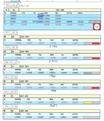I am having an issue with the CMM measuring dims out of tolerance. Screen shot of the CMM report is attached. A lot of these programs are from 2017 or 2018. They are not using CAD models. The CMM was calibrated Aug 2023. I'm very stuck on what else to look into.
I thought maybe it was a migration issue but this is a recent issue. Within the last 8 months.
I tried setting the FCF instead of using the x,y and z from measurements. i tried using the back up program. program is using a star probe so i switched it to a rotating probe, still didn't work.
Attached Files

